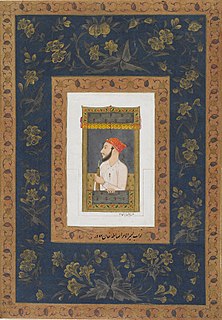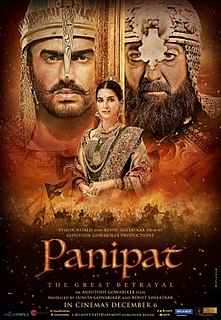
The Third Battle of Panipat took place on 14 January 1761 at Panipat, about 97 km north of Delhi, between the Maratha Empire and the invading Afghan army of the King of Afghans, Ahmad Shah Abdali, supported by three Indian allies — the Rohilla Najib-ud-daulah, Afghans of the Doab region, and Shuja-ud-Daula, the Nawab of Awadh. The Maratha army was led by Sadashivrao Bhau who was third in authority after the Chhatrapati and the Peshwa. The main Maratha army was stationed in Deccan with the Peshwa. Militarily, the battle pitted the artillery and cavalry of the Marathas against the heavy cavalry and mounted artillery of the Afghans and Rohillas led by Abdali and Najib-ud-Daulah, both ethnic Afghans. The battle is considered one of the largest and most eventful fought in the 18th century, and it has perhaps the largest number of fatalities in a single day reported in a classic formation battle between two armies.

The Maratha Empire or the Maratha Confederacy was a power that dominated a large portion of the Indian subcontinent in the 18th century. The empire formally existed from 1674 with the coronation of Shivaji as the Chhatrapati and ended in 1818 with the defeat of Peshwa Bajirao II by the hands of the British East India Company. The Marathas are credited to a large extent for ending Mughal rule in India.

Rohilkhand is a region in the northwestern part of the Uttar Pradesh state of India, centered around Bareilly and Moradabad divisions. Part of the upper Ganges Plain, the region is named after the Rohilla tribe who are either Pashtun or Hindu Rajput. The region was called Madhyadesh in the Sanskrit epics Mahabharata and Ramayana.

Balaji Bajirao Peshwa, also known as Nana Saheb, was a Peshwa of the Maratha Empire in India. He was appointed as Peshwa in 1740 upon the death of his illustrious father, the Peshwa Bajirao I.

Alamgir II was the Mughal Emperor of India from 3 June 1754 to 29 November 1759. He was the son of Jahandar Shah.

Shuja-ud-Daulah was the Grand Vizier, Subedar and Nawab of Oudh from 5 October 1754 to 26 January 1775.

Ali Gohar, historically known as Shah Alam II, was the sixteenth Mughal Emperor and the son of Alamgir II. Shah Alam II became the emperor of a crumbling Mughal empire. His power was so depleted during his reign that it led to a saying in the Persian language, Sultanat-e-Shah Alam, Az Dilli ta Palam, meaning, 'The empire of Shah Alam is from Delhi to Palam', Palam being a suburb of Delhi.

Raghunathrao Bhat was the 10th Peshwa of the Maratha Empire for a brief period from 1773 to 1774.

Mahadaji Shinde also spelled as Mahadji Scindia or Mahādajī Śhindē, was a Maratha Statesman and ruler of Gwalior in Northern India. He was the fifth and the youngest son of Ranoji Rao Scindia, the founder of the Scindia dynasty.

The Durrani dynasty was founded in 1747 by Ahmad Shah Durrani at Kandahar, Afghanistan. He united the different Pashtun tribes and created the Durrani Empire with his Baloch allies, which at its peak included the modern-day Afghanistan, Pakistan, as well as some parts of northeastern Iran, eastern Turkmenistan, and northwestern India including the Kashmir region. The Durranis were replaced by the Barakzai dynasty during the early half of the 19th century.

Shrimant Daulat Rao Sindhia (Shinde) was the king (Maharaja) of Gwalior state in central India from 1794 until his death in 1827. His reign coincided with struggles for supremacy within the Maratha Confederacy, and with Maratha resistance to the consolidation of British hegemony over northern and central India in the early 19th century. Daulatrao played a significant role in the Second and Third Anglo-Maratha wars.

Najib ad-Dawlah, also known as Najib Khan Yousafzai, was a Rohilla Yousafzai Pashtun who earlier served as a Mughal serviceman but later deserted the cause of the Mughals and joined Ahmed Shah Abdali in 1757 in his attack on Delhi. He was also a tribal chief in the 18th century Rohilkhand, who in the 1740s founded the city of Najibabad in Bijnor district, India.

The Maratha Conquests were a series of conquests in the Indian subcontinent which led to the building of the Maratha Empire. These conquests were started by Chatrapati Shivaji in 1659 from the victory at the Battle of Pratapgad against Bijapur. The empire was interrupted by the Mughal conquests of south India by Emperor Aurangzeb and lost its independence as well as execution of their kings which continued until the death of Bahadur Shah I in 1712.
Visaji Krushna Chinchalkar, popularly known as Visaji Pant Biniwale, was one of the leading Generals of Peshwas in Northern India during 1759 to 1772. Peshwa Madhavrao I mainly sought his assistance in his attempt to restore Maratha Empire in the North after the defeat in the Battle of Panipat (1761).

Zabita Khan Rohilla also known as Dharam Singh was Rohilla chieftain in the time of the Mughal Emperor Shah Alam II. He was the son of the Rohilla Sardar Najib-ud-Daula, who founded the city of Najibabad. Zabita Khan is also known to have fought alongside his father during the Battle of Panipat in 1761. After the death of his father on 30 October 1770, Zabita took over. During his rule, the Marathas captured, first Delhi in 1771 and then Rohilkhand in 1772, forcing him to flee to the camp of the Nawab of Awadh, Shuja-ud-Daula.

Shahzada Mirza Jawan Bakht Bahadur alternative spelling Mirza Javan Bakht, Mirza Jewan Bakht also known as Mirza Jahandar Shah born at the Red Fort, Delhi. He was the eldest son of Emperor Shah Alam II and the grandson of Emperor Alamgir II, Jawan Bakht was a very influential Timurid Prince of the Mughal Empire.
Dattaji Rao Scindia, also known as Dattaji Rao Shinde, was the second son of Ranoji Rao Shinde and Mina Bai, alias Nimba Bai. His elder brother was Jayappaji Rao Shinde and his younger brother was Jyotiba.
The Maratha Resurrection was the period between the Third Battle of Panipat on January 14, 1761 and capture of Najibabad in 1773.
The following is a timeline of the history of Delhi, including New Delhi. Changes in ruling nation are in bold, with a flag to represent the country where available.

Panipat is a 2019 Indian Hindi-language epic war film directed by Ashutosh Gowarikar. Starring Arjun Kapoor, Sanjay Dutt and Kriti Sanon, it depicts the events that took place during the Third Battle of Panipat. The film was theatrically released in India on 6 December 2019. The film was unsuccessful at the box office.














